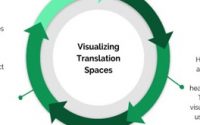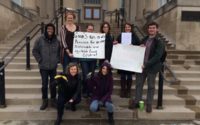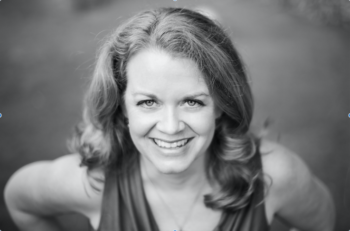No Más MAS: Teachers Defining Pedagogies and Themselves in a Post-Ethnic Studies Arizona
In Mestiz@ Scripts, Digital Migrations, and the Territories of Writing, Damián Baca writes of the ways that rhetoric and composition often conceals “the limits of an enduring Eurocentric teleology and its consequent dominant narrative of assimilation” (163). Now-banned1 Mexican American Studies (MAS) classes in Tucson, Arizona, were accomplishing some of the same goals Baca encourages: The K-12 courses (mostly literature, government, and history) worked directly against a notion of Eurocentric teleology, and expressly worked to counter a narrative or expectation of assimilation. The MAS program, which began as a series of social justice classes in Tucson Unified School District in 1997, countered a narrative of assimilation by directly incorporating the Indigenous, Mexican-American, and Euro-American perspectives that match the heritage of the majority of TUSD students.2 Teachers developed MAS courses to help Latin@3 students see themselves in school subjects and to try to overcome underachievement and low graduation rates. MAS courses celebrated students’ cultural backgrounds and demonstrated how those backgrounds mattered in the development of each student, the Tucson community, and the country (Federico-Brummer; Romero, “Preface”; Rusk). The courses helped students define themselves against a dominant cultural narrative of inferiority in Arizona, a state notorious for its expectations of assimilation and its unwelcoming manner toward immigrants—especially the Mexican immigrants and their descendants who form a significant segment of its population.
TUSD offered MAS classes until January 2011, after a December 2010 ruling that the Mexican American Studies classes were out of compliance with a new law, Arizona Revised Statute (ARS) 15-112. ARS 15-112, “Prohibited classes and courses; enforcement,” written specifically to challenge the MAS courses,4 prohibits classes that:
- Promote the overthrow of the United States government.
- Promote resentment toward a race or class of people.
- Are designed primarily for pupils of a particular ethnic group.
- Advocate ethnic solidarity instead of the treatment of pupils as individuals.
(An appeals court struck down the third part; the rest of the law stands.)
MAS teachers do not believe their classes violated any aspects of the law as it stands, but because of an administrative law judge’s interpretation that one or more of the classes did violate the law (Kowal), MAS was removed as a curricular option.5 Important to note is that the classes significantly increased student success by a variety of measures, and that an independent audit, the “Cambium Report,” provided what others considered to be overwhelming evidence that the classes did not violate any aspect of that law (Curriculum). What happened to Mexican American Studies in Tucson is—should be—important to educators and scholars who believe in providing locally and culturally relevant instruction to students and who believe in protecting students and teachers at all levels from being political targets. Further, this article demonstrates that political decisions have pedagogical implications that influence the identities and experiences of both teachers and students. I interviewed 14 former MAS teachers and students in Tucson seeking an understanding of the personal effects of the demise of MAS. I asked interviewees about their experiences with the program and their experiences and feelings about its dismantling and what came after. This article provides a snapshot of the personal and pedagogical effects of the political decision to shutter MAS on two former MAS teachers, Sally Rusk and María Federico-Brummer.6 Each has had to re-make, or re-define, herself and her pedagogies in the wake of Arizona Revised Statute 15-112 and a judge’s interpretation that MAS classes were breaking that law.7 The article explores how those events affected these two teachers’ self-definitions.
Sally Rusk, 50 at the time of our interview, is a white woman fluent in Spanish. Rusk has been teaching history and government in a west-side (read: mostly poor and mostly Mexican-American population) Tucson high school for over 20 years and has a long history of political activism. María Federico-Brummer, in her late 30s, describes herself as Indigenous. She teaches at another high school on Tucson’s west side, and since 2012, she has been teaching the district’s new culturally relevant classes, themselves controversial.
Rusk described the beginning of MAS as a kind of utopian experience:
I feel so lucky because being with the department . . . kept me in teaching because it was that philosophical bent, that critical pedagogy an in a supportive community of people who really were looking at, well, okay, how can we best serve our students? We worked within a system . . . a colonizing system . . . This class was about a group, about where we are, the southwest, about a group that has been left out of the [usual] curriculum.
Rusk emphasized both the specific location and culture of the course as well as the community of teachers. When asked to define the goals of the program, she described actions: “Consistently reflecting on our practice, consistently reflecting on what’s best for kids, having them see themselves in literature, in history, sharing activities, sharing lessons, doing research. . . . ” Rusk emphasized the ways teachers worked together. She also emphasized “reflection” both in terms of teachers regularly reflecting together on their practices and in terms of students seeing themselves reflected in the content of the courses.
Rusk’s experience with teaching MAS, then, is inextricable from her experiences working with a community of teachers who worked together and supported one another. Several teachers from across the district worked in hybrid positions, simultaneously in administrative roles running the MAS department and as teachers (a much more unusual workload distribution in K-12 situations than in higher education). Those teachers running MAS taught a few classes each year, but their schedules were otherwise freed up to research histories, literatures, and better ways to teach both students and one another.
MAS teacher-administrators devoted weekends to training other teachers and evenings to Encuentros: carefully planned encounters among students, parents, and teachers. Teachers and students I interviewed told me that students were excited to attend the Encuentros and that they dragged their parents to them. The Encuentros enjoyed record-high attendance in areas where family involvement in school activities is far from assumed (Romero, personal interview). Federico-Brummer attributed results like increased family involvement to students discovering “this is a different kind of educational setting, and this is what respect looks like, this is what love looks like . . . ” The goals of MAS were “to decrease that achievement gap [between Latin@ and white students] using culturally relevant, responsive curriculum, engaging our community and our family members and treating them with love and respect” (Federico-Brummer). In Rusk’s words, the MAS department “fomented and encouraged education—real education—that was really pulling students back in.” MAS teachers felt they were intervening in what is often an inhospitable culture of American schooling for Latin@ students (Valenzuela).
In January 2011, after MAS was deemed illegal, everything stopped. Teachers had to stop teaching the curriculum only a couple of weeks into the new spring semester. Administrators and their appointees physically removed several books from classrooms—in some cases while students were in class—in order to avoid a significant financial penalty for the district (Herreras). For the rest of that term and the entire next school year, with their curriculum literally removed, MAS teachers like Rusk and Federico-Brummer floundered for what to teach. Their curricula, and even they themselves as MAS teachers, had been defined by the state and the district as illegal. That question of illegality, though, is a complicated one, because there were legal implications for the lack of MAS classes, too. After all, as Rusk put it, MAS classes were “part of the deseg order.”
The “deseg order” is the federal desegregation order Tucson Unified School District has operated under since the 1970s, after a lawsuit brought by parents charging discrimination (“Supporting”). Since then, TUSD has been required to provide a multicultural curriculum that reflects the histories and perspectives of specific ethnic/racial populations (“Tucson”). In short, the MAS program that the state courts of Arizona made illegal was actually required by the Federal courts in order for the district to be operating legally. After the “complete destruction of [MAS]” (Rusk), the district was out of federal compliance and went back under direct court supervision (“Supporting”). In order to come back into compliance with federal requirements, the district had to implement new multicultural curricula (“Tucson”).
When the district sought teachers to develop a new multicultural curriculum, or “culturally relevant curriculum” (CRC), former MAS teachers—the local experts in such curricula—were the logical, if ironic, choice. Rusk and Federico-Brummer were among those who initially agreed to work on this new curriculum. Some former MAS teachers saw the CRC invitation as a chance to remake MAS; through the CRC, they hoped to redefine their pedagogies and themselves as legal and good. During the curriculum development process, however, many became disillusioned, coming to see CRC as a “washed down” version of MAS, a poor replacement for what had been a vibrant, focused curriculum (Federico-Brummer).
Rusk felt compelled to work on the culturally relevant curriculum despite worries that by doing so she was working against the return of actual MAS. She and her fellow former MAS teachers “agonized over this [request] because there was [a question of], ‘Are you being a scab?’” Although the teachers worried about sending the wrong message, many also felt so strongly about the topic and the students that they initially decided to participate.
Rusk struggled to define herself in this new context: she was a member of Save Ethnic Studies, a group pursuing a lawsuit to return MAS to the schools,8 but she was also a teacher dedicated to helping students and sharing materials with other teachers. She explains:
[We didn’t want to] go against the law, but we weren’t breaking any law anyway . . . it was hard, because people lost their jobs, so we had to really talk about that. . . . It was very, very, very, very painful. . . . We were working on the new curriculum and the message was always, “It’s gotta be different, it’s gonna be way better, it’s gotta be different, it’s gonna be way better, and you can’t use anything you’ve developed for 12 years, and the thing is . . . you have something that worked, and you want keep building on it . . . ”
Rusk’s struggle is evident in statements like these: it wasn’t just painful, it was “very, very very, very” painful. Four “very”s, each punctuated. She hesitated and trailed off as she spoke, her words attached to her deep feelings and her challenging, evolving definitions of herself as a teacher, activist, and strong believer in multicultural education. Self-definitions, as Jessica Enoch argues, “highlight the political nature of definitions as an assertion . . . that in many ways speaks back to [others’] debilitating definitions” (“Para la Mujer” 34-35). MAS, and by extension its teachers, had been defined as illegal by Arizona’s courts and many of its citizens. Rusk actively defined herself against these “debilitating definitions,” speaking back by working on the lawsuit and by trying to develop curriculum for CRC.
Eventually, on the curriculum matter, Rusk responded with what John Schilb might term a rhetorical refusal: she stopped working on the culturally relevant curriculum. She said, “it was so demoralizing. . . . I became disillusioned and I stopped.” For Rusk, being unable to use any of the materials she’d developed over more than a decade seemed to be forcing her to accept the state’s definition of her as a teacher of illegal things, a definition she resisted. In doing so, she illustrated Richard Lanham’s explanation of a “negative definition”: She defined herself by“proving what [she] is not” (47). She wasn’t alone: only one former MAS teacher was able to reconcile her own definition of herself and her definition of that “new” pedagogy to continue to develop and teach that new culturally relevant curriculum (CRC): Federico-Brummer.
Federico-Brummer struggled, too, but for her, working on the culturally relevant curriculum wasn’t so much a choice as a necessity: “I am the only teacher that’s gone on with the CRC classes. Part of it is just a sense of responsibility to our kids . . . I’m busy doing the work that I feel is important for my kids here, in this space, right now.” Federico-Brummer considers herself to be doing necessary work, and there’s a certain pride in that—“I’m unique,” she shares—but there is also loneliness. Of the differences between working with the CRC versus MAS (which had included the support of the MAS department), she acknowledges, “it’s different. I’m here by myself. I do have a colleague who’s teaching . . . Mexican-American Lit, but [we] don’t really collaborate at all, and we don’t have the same kids. . . . That energy’s not there, that expertise isn’t there.”
Whereas the other former MAS teachers couldn’t reconcile themselves with a replacement curriculum, Federico-Brummer couldn’t reconcile herself with continuing to offer the standard Eurocentric curriculum when she felt another would serve her students better. For her, the critical element of defining herself has to do with helping the high school students she sees every day—even if that means she is no longer involved in the broader fight to ensure that more students have access to that kind of curriculum. She says, “I guess [other] individuals made decisions [to not continue with the CRC], and I didn’t. I’m here; I’m teaching the classes; I developed the curriculum.”
In some ways, Federico-Brummer’s new CRC classes are much the same as her former MAS classes:
I kept as much as possible to what we had as Mexican American Studies previous to being shut down intact, and I continue to teach very much what I taught before . . . just making sure that the standards are very much aligned, and making it very transparent. . . . I’ve adapted, like every single teacher does, that, ‘Oh! This text is totally relevant, and this has the same point.’ It may not be a Chican@ author, and I think that’s been some of the critique: ‘Hey, you’re not even teaching a Chican@ author!’ Well, I’m sorry.
There’s a bit of a “sorry not sorry” tone to Federico-Brummer’s “Well, I’m sorry” for teaching non-Chican@ authors. Recall that for Rusk, the essence of MAS was that it was a class about a particular group in a particular place. For Federico-Brummer, though, the definition had more to do with emphasizing love and respect for students than the specifics of place and culture.
Federico-Brummer was originally part of Save Ethnic Studies group, the coalition of teachers fighting the anti-MAS legislation in the courts, but through her work creating a “replacement curriculum,” she also challenged that definition of illegality and wrongness. Federico-Brummer was able to get materials previously assumed to be insurrectionary approved by the district (or more specifically, by its schoolboard with some newly-elected pro-MAS members). By choosing to stick with the culturally relevant curriculum, Federico-Brummer expanded her definition of what those new classes could be in keeping with her interpretation of the spirit of MAS. Federico-Brummer had to define herself against the debilitating definitions of the state courts, the district, and anti-ethnic studies locals. She also had to define herself from the other side: against the definitions and accusations levied by some former colleagues and friends who saw the work she was doing as “accommodating the district,” or selling out.
Making that choice caused Federico-Brummer to be left out of the Save Ethnic Studies group. In another instance of a rhetorical refusal, the group never explicitly cast her out; they simply stopped inviting her to meetings. The Save Ethnic Studies group came to define the culturally relevant curriculum as one that could not and should not replace MAS, the implication being that its implementation would stall or thwart the reinstallation of MAS they were all fighting for. In doing so, they applied a prescriptive definition to the culturally relevant curriculum. Lanham defines “prescriptive definition” as the “insistence that a certain definition is the only one acceptable” (47). Once many individuals within that group had determined that working on the CRC curriculum wasn’t acceptable, once they had defined it as too problematic to continue working on, their prescriptive definition expanded to include Federico-Brummer herself as unacceptable.
While Federico-Brummer’s choice—the only one she felt she could make and stay true to herself—was to continue the work any way she could, Rusk’s (and other MAS teachers’) was the opposite. I want to be clear that I’m not making an argument about either choice being right or wrong. What I am arguing is that each of these women worked to re-define herself and her pedagogies in a challenging, changing political and pedagogical environment. Each woman’s self-definition is a response to various power structures, and each woman finds strength in her choice, however fraught the process, which offers one reiterated lesson and one extrapolated lesson: The political? It’s personal. And the pedagogical? That’s personal, too.
Rusk’s and Federico-Brummer’s are but two of many reactions to an educational program being politically and ideologically targeted. Every MAS teacher was forced to make difficult decisions—a few escaped to administrative roles or academe; some teach non-MAS, non-CRC classes but still strive to embody the core elements of their experiences as MAS teachers; one was dismissed from the district. In an era of increasingly vocal and political challenges to and distrust of education at all levels, what happened to MAS may be less of an anomalous tragedy than a harbinger of what’s to come. These teachers’ responses, while in some ways particular to individuals and relating to a particular political issue, also illustrate the splintering, echoing effects of political and judicial decisions on teachers, schools, and the entire enterprise that is education. The ways politicians define and delimit scholastic programs affect not only particular teachers, not only particular districts or places, but the larger landscape of what education in the US is and can be. The dismantling of MAS is a micro-event with macro implications for all who believe in an education that serves students and opens minds.9
Endnotes
- After this article was accepted, but before it was published, U.S. District Judge A. Wallace Tashima ruled that ARS 15-112 was unconstitutional, violating the first and 14th amendments. Details of a resurrection of MAS/replacement of the current CRC have not been worked out. For more information and the text of Wallace’s ruling, see Dylan Smith, “Judge: Law barring TUSD’s ethnic studies unconstitutional, motivated by racism.” return
- The range of Latin@ students at included high schools varies from about 60-90% (“School”). return
- As Sandra Soto explains, the nonalphabetic @ symbol combines gendered Spanish words like Latino (masculine) and Latina (feminine) [and I would argue that its swirl makes it inclusive of a spectrum of gender identities], but also to catch the reader’s eye and “announce a politicized collectivity” (2). Soto suggests pronouncing the @ with a dipthong: “ao” (like the “ow” sound in “pow”). return
- See Lundholm, Nicholas B. “Cutting Class: Why Arizona’s Ethnic Studies Ban Won’t Ban Ethnic Studies” for a detailed account of this rationale and its legal history. return
- See also Aronson, Deb. “Arizona Bans Mexican American Studies Program: “It was never about what we were doing, it was about who we are.” return
- Both women gave permission for me to use their full names in their IRB-approved consent forms. return
- The Cambium Report was commissioned by John Huppenthal, then Arizona State Schools Superintendent. Huppenthal objected to the existence of MAS and no doubt requested the report expecting it to find evidence that MAS teachers were encouraging the overthrow of the American government, among other violations of ARS 15-112. On the contrary, however, the report—which relied on a variety of data includingfocus group interviews, analysis of classroom materials and district data, and unannounced classroom observations and—found “no observable evidence” of such violations and instead lauded the program’s pedagogical appropriateness and success. Nevertheless, the unambiguously positive report did not sway Judge Kowal to a favorable ruling. return
- The lawsuit, Arce v. Douglas, continues to work its way through the court system, with the most recent ruling from the Ninth Circuit in 2015 and a trial in progress as of this writing in 2017. return
- For more detail on the content of the MAS program and the fallout of its demise, see Kim Hensley Owens’ “In Lak’ech, The Chicano Clap, and Fear: A Partial Rhetorical Autopsy of Tucson’s Now-Illegal Ethnic Studies Classes,” College English, published January 2018. return
Works Cited
- Aronson, Deb. “Arizona Bans Mexican American Studies Program: ‘It was never about what we were doing, it was about who we are.’” Council Chronicle, vol. 22, no. 1, 2012, pp. 21-23.
- Baca, Damián. Mestiz@ Scripts, Digital Migrations, and the Territories of Writing. Palgrave MacMillan, 2008.
- Cambium Learning. Curriculum Audit of the Mexican American Studies Department Tucson Unified School District. Tucson, AZ, 2011.
- Enoch, Jessica. “Para La Mujer: Defining a Chicana Feminist Rhetoric at the Turn of the Century.” College English, vol. 67, no. 1, 2013, pp. 20–37.
- Federico-Brummer, María. Personal interview. 11 Feb. 2014.
- González, José. Personal interview. 12 Feb. 2014.
- Herreras, Mari. “TUSD Banning Books? Well Yes, and No, and Yes.” Tucsonweekly.com, 17 Jan. 2012, www.tucsonweekly.com/TheRange/archives/2012/01/17/tusd-banning-book-well-yes-and-no-and-yes.
- Kowal, Lewis B. “In the Matter of the Hearing of an Appeal by Tucson Unified School District No. 1,” No. 11F-002-ADE. Administrative Judge Law Decision, 16 Dec. 2011, www.azag.gov/sites/default/files/sites/all/docs/TUSD_Ethnic_Studies_Ruling.pdf. Accessed 2 Jul. 2017.
- Lanham, Richard A. A Handlist of Rhetorical Terms, 2nd ed., U of California P, 1991.
- Lundholm, Nicholas B. “Cutting Class: Why Arizona’s Ethnic Studies Ban Won’t Ban Ethnic Studies.” Arizona Law Review, vol. 53, no. 3, 2001, pp. 1041-1088.
- Ninth Circuit. Arce v. Douglas. 7 July 2015, cdn.ca9.uscourts.gov/datastore/opinions/2015/07/07/13-15657.pdf.
- Owens, Kim Hensley.“In Lak’ech, The Chicano Clap, and Fear: A Partial Rhetorical Autopsy of Tucson’s Now-Illegal Ethnic Studies Classes.” College English, vol. 80, no. 3, January 2018, pp. 247-270.
- Romero, Augustine. “Preface: Revolutionary Education in Tucson.” Raza Studies: The Public Option for Educational Revolution. Edited by Julio Cammarota, Augustine Romero, and David Stovall, U of Arizona P, 2014, pp. xiii–xxi.
- Romero, Augustine. Personal interview. 11 Feb. 2014.
- Rusk, Sally. Personal interview. 10 Feb. 2014.
- Schilb, John. Rhetorical Refusals: Defying Audience’s Expectations. Southern Illinois UP, 2007.
- “School Enrollment by Gender/Ethnicity on Any Day.” TUSD.org. tusdstats.tusd1.org/planning/profiles/curr_enr/anydate/anyenr_front.asp. Accessed 27 Jan. 2017.
- Smith, Dylan. “Judge: Law barring TUSD’s ethnic studies unconstitutional, motivated by racism.” TucsonSentinel.com, 22 Aug. 2017, www.tucsonsentinel.com/local/report/082217_tusd_mas/judge-law-barring-tusds-ethnic-studies-unconstitutional-motivated-by-racism/.
- Soto, Sandra K. Reading Chican@ like a Queer: The de-Mastery of Desire. U of Texas P, 2010.
- “Supporting Documents for the Unitary Status Plan.” Tucson Unified School District, Tucson Unified School District, 201, http://deseg.tusd1.schooldesk.net/USPPlanandDocuments/tabid/78294/Default.aspx. Accessed 2 July 2017.
- “Tucson Unified School District Unitary Status Plan.” United States District Court of Arizona. Case 4:74-cv-00090-DCB, Document 1450, 20 Feb. 2013, www.azd.uscourts.gov/sites/default/files/cases%20of%20interest/74-90-1450.pdf. Accessed 2 July 2017.
- Valenzuela, Angela. Subtractive Schooling: U.S.- Mexican Youth and the Politics of Caring. State U of New York P, 1999.
Cover Image Credit: www.flickr.com/photos/26438012@N08/14155278805
Keywords: identity, self-definition, ethnic studies, Mexican-American Studies, Tucson, politics




 Kim Hensley Owens directs the University Writing Program and is associate professor of English at Northern Arizona University. Her work focuses on embodied rhetoric, rhetorical agency, rhetorics of health and medicine, and pedagogy. Recent publications include a College English article about Tucson’s Mexican American Studies program and her book, Writing Childbirth: Women’s Rhetorical Agency in Labor and Online.
Kim Hensley Owens directs the University Writing Program and is associate professor of English at Northern Arizona University. Her work focuses on embodied rhetoric, rhetorical agency, rhetorics of health and medicine, and pedagogy. Recent publications include a College English article about Tucson’s Mexican American Studies program and her book, Writing Childbirth: Women’s Rhetorical Agency in Labor and Online.